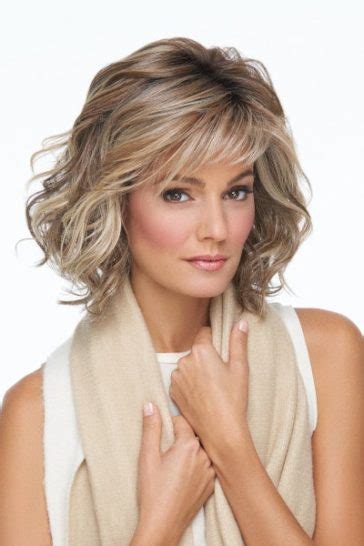The Silver Lining to Aging: Wigs for the Modern Woman
As women age, their hair may naturally thin or change texture. While this can be a source of frustration, it’s also an opportunity to embrace a new look with a wig. Wigs offer a myriad of benefits, such as:

- Unlimited style options: Explore different lengths, colors, and textures without damaging your own hair.
- Volume and fullness: Add instant volume and thickness to thinning hair, boosting confidence.
- Versatile styling: Wear your wig straight, curled, braided, or up in a sophisticated bun.
- Protection: Wigs shield your scalp from sun damage, wind, and pollutants.
- Privacy: Conceal hair loss, bald spots, or scars with a natural-looking wig.
How to Choose the Right Wig: A Step-by-Step Guide
Step 1: Determine Your Face Shape
Identify the shape of your face to select wigs that flatter your features:
– Oval: Any wig style will complement your balanced face shape.
– Round: Wigs with side-swept bangs or longer layers will elongate your face.
– Square: Choose wigs with soft fringes or face-framing layers to soften your angles.
– Heart: Opt for wigs with voluminous crowns and tapered ends to balance your wider forehead.
Step 2: Consider Your Hair Color and Texture
Match your wig to your natural hair color for a seamless transition. If you’re unsure, consult a stylist for personalized advice. Consider your hair texture as well:
– Fine hair: Choose wigs with thin fibers and a natural sheen.
– Coarse hair: Opt for wigs with stronger fibers and a coarser texture.
– Curly hair: Explore wigs with defined curls or waves.
Step 3: Choose the Right Cap Construction
The cap construction determines the fit and comfort of your wig:
– Lace front wigs: Provide a realistic hairline and natural-looking part.
– Monofilament wigs: Create the illusion of hair growing from your scalp.
– Capless wigs: Lightweight and breathable, ideal for warm climates.
Step 4: Measure Your Head
Measure the circumference of your head to ensure a snug fit. The standard size for wigs is 22.5 inches, but you can find wigs in sizes ranging from 21 to 24 inches.
25 Stunning Wig Styles for Women Over 50
Short, Chic Cuts:
– Pixie: Edgy and easy to style
– Bob: Timeless and elegant
– Short Layered: Adds volume and movement
Mid-Length Mane:
– Lob (Long Bob): Modern and versatile
– Shoulder-Length Shag: Effortlessly cool and casual
– Wavy Layered: Flattering for all face shapes
Long and Luxurious:
– Straight and Sleek: Sophisticated and glamorous
– Curly Cascade: Dramatic and voluminous
– Ombré Layers: Adds depth and dimension
10 Tips for Styling and Maintaining Your Wig
- Use a wig brush specifically designed for wigs.
- Wash your wig every 6-8 wears or as needed with a gentle shampoo and conditioner.
- Condition your wig regularly to keep it soft and manageable.
- Let your wig air dry naturally.
- Store your wig on a wig stand or mannequin to maintain its shape.
- Avoid using heat styling tools on your wig.
- Trim any split ends promptly to prevent further damage.
- Protect your wig from chlorine by wearing a swim cap.
- Consider professional wig styling for a special occasion.
- Enjoy experimenting with different styles and colors to find the perfect look for you.
3 Ways to Save Money on Wigs
- Shop online for wider selection and competitive prices.
- Consider buying a synthetic wig, which is more affordable than human hair wigs.
- Attend wig sales or ask about discounts.
4 Signs You Need a New Wig
- Your wig is shedding excessively.
- Your wig has lost its luster or shine.
- Your wig is tangled or matted.
- Your wig no longer fits properly.
Table 1: Types of Wig Caps and Their Benefits
| Cap Type | Benefits |
|---|---|
| Lace Front | Natural-looking hairline, versatile styling options |
| Monofilament | Breathable, creates the illusion of natural hair growth |
| Capless | Lightweight, comfortable, ideal for warm climates |
| Weft | Inexpensive, durable |
Table 2: Pros and Cons of Human Hair vs. Synthetic Wigs
| Wig Type | Pros | Cons |
|---|---|---|
| Human Hair | Natural look and feel, versatile styling options | Expensive, requires more maintenance |
| Synthetic | More affordable, easy to care for | Less natural appearance, less heat resistant |
Table 3: Average Wig Prices by Type
| Wig Type | Average Cost |
|---|---|
| Human Hair | $200-$1,000+ |
| Synthetic | $50-$200 |
| Custom-Made | $500-$2,000+ |
Table 4: Wig Maintenance Checklist
| Task | Frequency |
|---|---|
| Wash and condition | Every 6-8 wears |
| Brush | Daily |
| Trim split ends | As needed |
| Store properly | After every use |
| Use heat styling tools | Avoid if possible |
